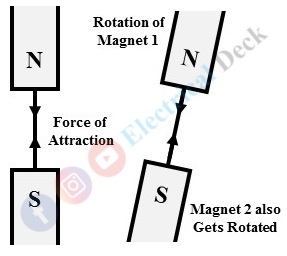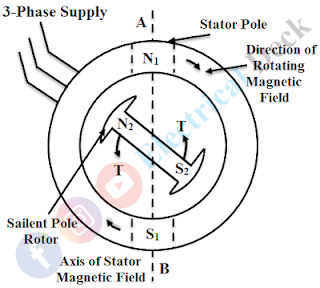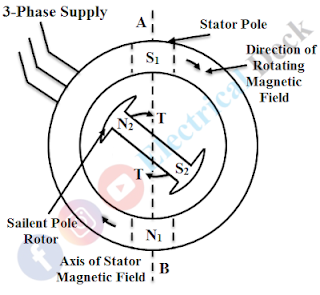A device that converts electrical energy into mechanical energy running at synchronous speed (or constant speed) is called Synchronous Motor. Its speed is constant irrespective of load. It is a doubly excited machine because its field winding is excited from a separate dc source. In the last article, we have seen the construction of a synchronous motor. Let us see the working principle and operation of a synchronous motor.
Magnetic Locking :
The concept behind the working of a synchronous motor is 'Magnetic Locking' i.e., it works on the principle of force of attraction between two magnetic poles. We know that when two unlike magnetic poles (N and S) are placed close to each other there exists a strong attraction force between two poles (i.e., they pull each other). This strong force of attraction is said to be magnetic locking.
Suppose if any magnet is rotated by an external force, the other magnet also gets rotated in the same direction due to magnetic locking as shown above. But in order to exist magnetic locking condition, there must be two, unlike poles. Otherwise, the magnets get repel each other, if N and N or S and S are placed close to each other.
Working Principle of Synchronous Motor :
Let us see the working principle of a synchronous motor with the above magnetic locking condition. When a 3-phase supply is given to the stator winding of the motor. It setups magnetic poles of N1 and S1. Due to the effect of these stator magnetic poles, a magnetic field rotating at a constant speed or at synchronous speed Ns is produced.
Case - 1 :
During the first half cycle of the supply. Let A and B are two positions of the stator magnetic poles N1 and S1. Also, N2 and S2 are the arbitrary positions of the rotor magnetic poles as shown in the below figure.
At this position, since two unlike poles will attract each other, The stator pole N1 will try to attract rotor pole S2 and N2 with S1. At the same time, the two, unlike poles, will repel each other. This force of attraction causes the rotor to generate a torque on it. Hence rotor will rotate in an anti-clockwise direction.
Case - 2 :
Now after the completion of half cycle. The stator poles N1 and S1 will interchange, as the next half cycle of the supply will be negative. Now, here the condition will be reversed i.e., the stator pole S1 will attract rotor pole N2, and the poles S1 and S2 will repel each other. This causes a torque on the rotor to rotate in opposite direction (clockwise direction).
This process will go on to continue as the supply changes for every half cycle. But due to continuous and rapid rotation of stator poles (speed of rotating magnetic field is very high), the rotor gets subjected to quickly reversing torques.
Due to the inertia of the rotor, it will not respond to such torques and it will remain stationary and the motor fails to start. Hence a synchronous motor is not a self-starting motor.



